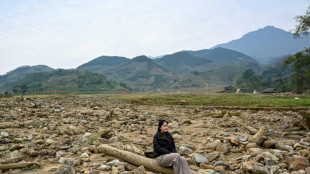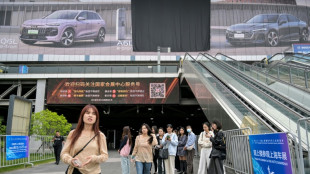
-
 Vietnam village starts over with climate defences after landslide
Vietnam village starts over with climate defences after landslide
-
'Happiness, love' at Moonie mass wedding after Japanese court blow

-
 Veteran Chinese astronaut to lead fresh crew to space station
Veteran Chinese astronaut to lead fresh crew to space station
-
Pilgrims gather as Pope Francis begins lying in state

-
 Asian markets rally as Trump comments ease Fed, China trade fears
Asian markets rally as Trump comments ease Fed, China trade fears
-
Saudi 'city of roses' offers fragrant reminder of desert's beauty

-
 Trump says won't fire Fed chief, signals China tariffs will come down
Trump says won't fire Fed chief, signals China tariffs will come down
-
India hunts gunmen who massacred 26 in Kashmir tourist hotspot

-
 'No one else will': Sudan's journalists risk all to report the war
'No one else will': Sudan's journalists risk all to report the war
-
UK hosts new round of Ukraine talks

-
 Trial testimony reveals OpenAI interest in Chrome: reports
Trial testimony reveals OpenAI interest in Chrome: reports
-
Tokyo's newest art star: one-year-old Thumbelina

-
 Ronaldo hunts Asian Champions League glory in Saudi-hosted finals
Ronaldo hunts Asian Champions League glory in Saudi-hosted finals
-
Scientists sound alarm as Trump reshapes US research landscape

-
 Trump's return boosts Israel's pro-settlement right: experts
Trump's return boosts Israel's pro-settlement right: experts
-
Trump solo: first lady, children out of frame in new term

-
 Climate watchers fret over Trump's cut to sciences
Climate watchers fret over Trump's cut to sciences
-
Moving fast and breaking everything: Musk's rampage through US govt

-
 'Everyday attack' - Trans youth coming of age in Trump's America
'Everyday attack' - Trans youth coming of age in Trump's America
-
A stadium and a jersey for Argentina's 'Captain' Francis

-
 New Trump task force vows to root out 'anti-Christian bias'
New Trump task force vows to root out 'anti-Christian bias'
-
Auto Shanghai showcases new EV era despite tariff speedbumps

-
 Trump's administration moves to scrap artificial food dyes
Trump's administration moves to scrap artificial food dyes
-
Musk to reduce White House role as Tesla profits plunge

-
 US official backs off promise to solve cause of autism by September
US official backs off promise to solve cause of autism by September
-
Guardiola joy as Man City go third after dramatic win over Villa

-
 Trump says has 'no intention' of firing Fed chief
Trump says has 'no intention' of firing Fed chief
-
Jury finds New York Times did not libel Sarah Palin

-
 UN appoints envoy to assess aid for Palestinians
UN appoints envoy to assess aid for Palestinians
-
Celtics star Tatum 'doubtful' for game two against Magic

-
 Former England star Flintoff reveals mental battle after car crash
Former England star Flintoff reveals mental battle after car crash
-
Defending champion Korda chases first win of season at Chevron Championship

-
 Olmo fires Liga leaders Barca past Mallorca
Olmo fires Liga leaders Barca past Mallorca
-
Nunes strikes at the death as Man City sink Villa to boost top-five bid

-
 Tesla says profits plunge 71%, warns of 'changing political sentiment'
Tesla says profits plunge 71%, warns of 'changing political sentiment'
-
WHO announces 'significant' layoffs amid US funding cuts

-
 PSG draw with Nantes to stay unbeaten in Ligue 1
PSG draw with Nantes to stay unbeaten in Ligue 1
-
Trump's administration moves to ban artificial food dyes

-
 Gunmen kill dozens of civilians in Kashmir tourist hotspot
Gunmen kill dozens of civilians in Kashmir tourist hotspot
-
US Treasury chief expects China tariff impasse to de-escalate

-
 I.Coast opposition leader Thiam barred from presidential election
I.Coast opposition leader Thiam barred from presidential election
-
Top US court leans toward parents in case on LGBTQ books in schools

-
 At least 24 killed in Kashmir attack on tourists
At least 24 killed in Kashmir attack on tourists
-
Rahul powers Delhi to big win over Lucknow in IPL

-
 Colombian cycling star 'Lucho' Herrera denies murder conspiracy
Colombian cycling star 'Lucho' Herrera denies murder conspiracy
-
Trump, Zelensky to attend Pope Francis's funeral Saturday

-
 US State Department to cut positions, rights offices
US State Department to cut positions, rights offices
-
Ukraine ready for direct talks with Russia only after ceasefire: Zelensky

-
 Myanmar Catholics mourn pope who remembered their plight
Myanmar Catholics mourn pope who remembered their plight
-
Pope's Vatican 'family' pay tearful respects


Rapid scale-up of CO2 removal crucial for climate goals
Capping global warming at liveable levels will be impossible without massively scaling up the extraction of planet-warming carbon dioxide from the atmosphere, the first global assessment of CO2 removal warned Thursday.
The persistent failure to draw down greenhouse gas emissions -- nearly 60 billion tonnes a year of CO2 or its equivalent -- has forced once-marginal carbon dioxide removal (CDR) options toward centre stage in climate policy, investment and research.
Across methods ranging from tree planting to factory-sized machines that suck CO2 from the air and store it underground, CDR worldwide currently captures two billion tonnes of the gas each year, according to the State of Carbon Dioxide Report.
More than 99 percent is extracted through "conventional" techniques such as restoring and expanding CO2-absorbing forests and wetlands.
Only a tiny fraction -- about 0.1 percent -- is removed by "novel" technologies such as direct air capture, converting organic waste into rock-like biochar, or capturing the CO2 from plants grown and burned for fuel, more than two dozen experts concluded.
The UN's climate science advisory body, the IPCC, has said carbon emissions must decline some 45 percent compared to 2020 levels by the end of this decade, and to net zero by mid-century, if Paris Agreement goals are to be met.
The 2015 treaty enjoins nations to hold warming to "well below" two degrees Celsius compared to preindustrial levels. The IPCC later concluded that only the agreement's aspirational 1.5C target could prevent severe, and potentially catastrophic, climate impacts.
"Regardless of whether we do a little or a lot of carbon dioxide removal, we will still have to do massive reductions in greenhouse gas emissions," report co-author Gregory Nemet, a professor at the University of Wisconsin–Madison, told AFP.
But CO2 emissions in 2022 remained at near-record levels, thrusting CDR into an even more critical role.
By the end of the century, the report calculates for the first time, CDR must extract between 450 billion and 1.1 trillion tonnes of CO2.
The new report says that conventional, tree-planting CDR -- even if emissions do drop sharply -- must double by 2050 to keep the 1.5C target in play, and increase by 50 percent to hold warming under 2C.
- Scaling up massively -
Research, however, has shown that food, energy and climate needs could result in competition for land, even with efficiency gains in each sector.
A deeply changing climate with only 1.2C of warming to date could also limit potential.
"If warming continues -- and all signs say it will -- then it will be even harder to maintain current levels of conventional CDR because they will be affected by droughts, storms, pests and other impacts," said co-author Oliver Geden, a senior fellow at the German Institute for International and Security Affairs and an IPCC lead author.
That means novel CDR methods have to pick up the slack.
To keep warming under 2C, deployment of these nascent technologies must be ramped up 30-fold by 2030, and by more than 1,000-fold by 2100, according to the report, led by the University of Oxford.
The 1.5C target would require scaling up even faster.
"Many policymakers don't know -- and probably don't want to know -- how much keeping the 1.5C narrative alive actually depends on carbon dioxide removal," Geden told AFP.
One novel CDR technology has attracted more attention -- and money -- than any other, even if it has barely put a dent in global emissions: direct air capture combined with carbon storage (DACCS).
Three quarters of the $200 million (185 million euros) invested in new CDR capacity from 2020 to 2022 went to direct air capture -- a big chunk of it to Switzerland-based Climeworks. The firm announced last week the world's first certified CO2 removal and storage on behalf of paying clients, including Microsoft and software service company Stripe.
"All this investment is based on the assumption that direct air capture can grow from about 10,000 tonnes today to a billion tonnes by 2050" -- a 100,000-fold increase, said Nemet.
That rate of growth is not necessarily out of reach, he said.
In earlier research, Nemet compiled a database of 135 technologies that emerged over the last century, looking at how quickly they scaled up.
The growth rate for solar panels has been about 30 percent a year over 30 years, he found.
"Direct air capture needs to be more than 40 percent for the next 30 years," he said. "It's a huge challenge, but it's not unprecedented."
M.Furrer--BTB


